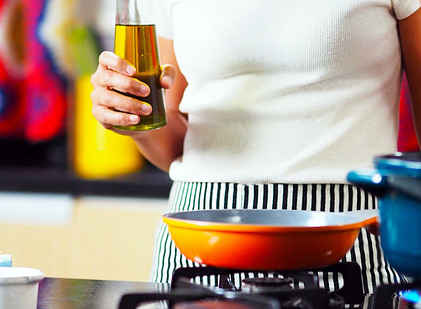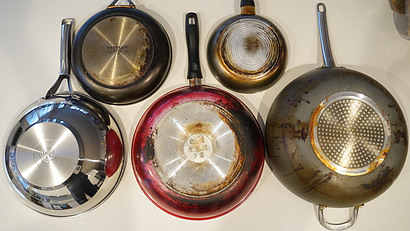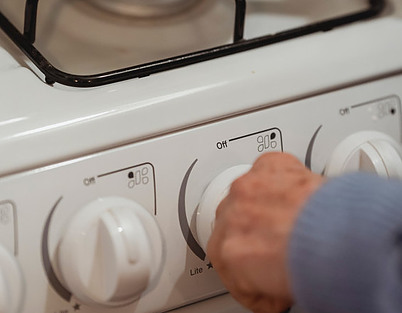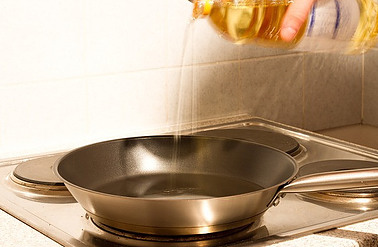Cooking oil is essential for processes like frying, searing, sauteing, and grilling.
There is a risk when using cooking in a pan, that is cooking oil burning.
Cooking oil burning not only creates a fire hazard in the kitchen and home, it also releases harmful smoke and chemicals that can be hazardous to your health.
This post I am going to discuss how to not burn cooking oil in a pan.
I Hope this post is able to solve your problem.
Table of Contents
How to not burn cooking oil in a pan?
Basically monitoring the temperature of the pan to prevent the cooking oil temperature rise to smoking point, then reach fire point and burn. Choosing the right oil and proper ways of gauging the pan temperature are the ways to reduce oil fire burning on the pan.
Choose the right type of cooking oil.
When cooking oil heated until its smoke point, it will break down and start to smoke.
Further heating cooking oil will cause the oil to reach the fire point where the oil starts to catch fire and burn on the pan.
Choosing a high smoke point cooking oil can reduce the risk of oil burning on a pan as high smoke point oil can withstand higher temperatures without breaking down or smoking, which can lead to oil fire burning.
Please take note, high smoke points only reduce risk of burning, there are still other factors that contribute to cooking oil burning on a pan, which will be explained further below.
Different oils have different smoke points.
Here is a list of cooking oils with high smoke points for your reference:
a) Palm oil (refined): 450°F (232°C)
b) Avocado oil: 520°F (271°C)
c) Refined high-oleic sunflower oil: 450°F (232°C)
d) Almond oil: 430°F (221°C)
e) Refined safflower oil: 510°F (266°C)
f) Refined peanut oil: 450°F (232°C)
g) Refined canola oil: 400°F (204°C)
h) Soybean oil: 450°F (232°C)
i) Rice bran oil: 450°F (232°C)
j) Grapeseed oil: 420°F (215°C)
k) Sesame oil (refined): 410°F (210°C)
l) Corn oil: 450°F (232°C)
m) Clarified butter (ghee): 482°F (250°C)
Monitoring the pan temperature with proper ways.
Overheating the pan will cause cooking oil temperature to rise quickly until smoke point and then burn.
So before putting oil into the pan, it is necessary to measure the pan temperature.
Infrared thermometer or temperature gun is one of the tools for measuring pan temperature, which is a device that measures temperature by detecting the infrared emitted by hot objects.
But infrared temperature guns are not accurate when measuring the temperature of dry, shining, and light reflective stainless steel pan.
When it comes to measuring reflective metal surfaces like stainless steel pan, suggest using a good quality infrared thermometer with adjustable emissivity and a high distance-to-spot ratio features.
A shining metal surface reflects more infrared radiation than they emit and a metal is low emissivity.
A infrared thermometer gun with adjustable emissivity able to compensate by adjusting the reading based on the material being measured.
An infrared thermometer gun with high distance-to-spot ratio features allows you to measure a smaller area from a greater distance.
By having a high distance-to-spot ratio, the thermometer can measure the temperature of a smaller area from a greater distance, reducing the impact of the reflected infrared radiation and resulting in more accurate temperature readings.
Beside the infrared thermometer, there is another simple way to gauge the temperature on the pan, by sprinkling water to the heated pan.
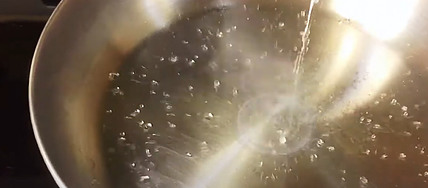
First heat the pan, then sprinkle a few drops of water onto the surface of the pan to observe the water behavior.
When the water evaporates immediately with a sizzling sound, it means the pan is still not hot enough for cooking.
Keep sprinkle the water on the pan and observe the water behavior.
Once the water droplets start skittering and “dancing” on the pan, it means the pan is hot enough for cooking.
This is called the Leidenfrost effect, but this method has its disadvantages.
The water droplet levitates on the hot pan surface at or above 193 °C approximately.
Water droplets dancing on the pan doesn’t mean 193°C, it could be 200°C or more.
So you need to keep observing the water behavior on the pan, once the water droplets start to dance, then quickly lower down the heat setting and put in the cooking oil.
Wrong gauging of pan temperature could cause you to burn cooking oil on the pan.
Use a heavy bottom pan to prevent hot spots.
A hotspot area temperature is significantly higher than the surrounding area, which may cause oil and food burning.
A heavy bottom pan has a thicker base, which is able to absorb and retain heat from the heat source, then effectively distribute the heat throughout the pan.
A thin pan can more easily form hotspots and cause burning
Use a low to medium heat setting to start heating the pan.
Take a longer time to heat the pan.
Start heating the pan from low to medium heat, increase the pan temperature gradually.
While heating the pan, keep testing the pan temperature by infrared thermometer gun or sprinkle the water to the hot pan and observe its behavior as mentioned above.
Once the pan temperature achieves your desired temperature (below oil smoking point or the ideal temperature for frying is between 350-375°F), turn off the heat and set at lowest heat setting, then put in the cooking oil.
Once the food is added into the pan, adjust the heat as needed for your cooking requirement.
Watch the heat, if oil starts smoking, turn the heat down or move the pan away from the heat source for a few minutes to cool down the pan temperature.
Put more oil into the pan when heating it.
Putting more oil could absorb more heat and temperature rise slowly compared to less oil.
When putting a small amount of oil into a heated pan, the oil temperature will rise faster and easily achieve smoke point and then burning.
For example, if you are frying food, suggest adding oil to cover the pan completely with an extra inch or so of oil on top.
You may put the oil into the pan before heating.
Another way to keep the oil from burning is put the oil into the cold pan and heat them.
Before putting the oil, make sure the empty pan is dry, a wet pan could cause oil splattering later.
When the oil slightly smoke, turn off the heat.
Then add in the food and after that adjust the heat according to your cooking requirement.
The bad of this method is when the oil reaches smoking point, it will break down and degrade, causing unpleasant taste and potentially harmful compounds being released into the air.
To prevent unpleasant taste in the food, you may dump the oil which is already heated and reach smoking point, then add in new oil into the pan.
Final Thought
By following these methods, I hope you are able to prepare a tasty meal with safety in the first place.
- Choose the right oil
- Keep monitoring the heat temperature before putting oil.
- Use a heavy base pan.
- Slowly heating the pan.
- Use more oil.
- Or heat the cold pan together with oil.
Please always have a lid (cover the fire pan), heat resistant utensil (remove the burning pan from heat source), and baking soda or salt (spray on the burning oil) for emergency use.
Happy and safe cooking!
